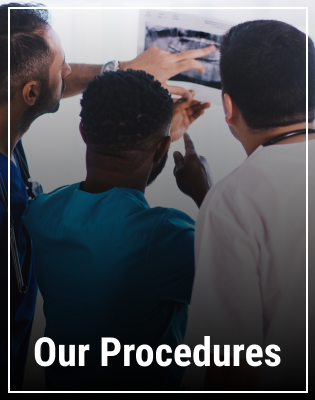What is it?
Craniotomy is an operation that involves removing a piece of bone from the skull (cranium) to provide access to the brain and its surrounding structures. The term craniotomy is derived from the Latin words cranium (head) and -otomy (act of cutting, incision).
The human skull, which is formed by the union of several cranial and facial bones, is anatomically divided into five regions: an upper region or vertex, a lower region or base, two side regions, and a frontal region, the face. The region of the skull through which the surgeon selects to perform a craniotomy is based on the type of condition requiring treatment. A skull base craniotomy is performed, for example, to treat Chiari (kee-ar-ee) malformations – congenital abnormalities of the base of the brain where the spinal column joins the skull. Named after Professor Hans Chiari – the German pathologist who in 1890 first described these abnormalities of the brain, these malformations usually cause a protrusion of the cerebellum through the bottom of the skull into the spinal canal, which results in poor circulation of cerebrospinal fluid from the brain to the spinal cord.
Why is it done?
Patients who suffer from the following cranial conditions are potential candidates for this operation:
- Tumors (e.g., brain, pituitary, optic nerve, acoustic neuroma)
- Cysts (e.g., arachnoid, colloid)
- Bleeding (hemorrhage)
- Blood clots (hematomas) from injuries (subdural hematomas or epidural hematomas)
- Weaknesses in blood vessels (cerebral aneurysms)
- Abnormal blood vessels (AVMs or arteriovenous malformations)
- Damage to the tissue covering the brain (dura)
- Cerebrospinal fluid (CSF) leaks
- Chiari malformations
- Premature fusion of the normally separate bones of the skull (craniosynostosis)
- Infection in the brain (brain abscesses)
- Skull trauma (e.g., fractures)
The Operation
An understanding of what a craniotomy involves will help you to approach your operation and recovery with confidence.
Incision
Part of the scalp is shaved and cleaned. An incision is then made through the scalp to the skull.
Exposure
A small hole, called a burr hole, is drilled through the skull to the brain. In some cases, several burr holes are drilled to allow your surgeon to lift and remove a piece of the bone. The bone between these holes is cut to create a flap in the skull through which the surgeon can access the brain and its surrounding structures. Next, the dura is cut to expose the brain.
Related Procedure
At this point in the operation, depending on the condition for which you are receiving treatment, several different procedures are performed. For example, your surgeon may remove tumors, clip aneurysms, drain cysts or shunt blood clots (a passage created between two natural bodies, such as blood vessels, shunts divert or permit flow from one body to the other).
Closure
The dura is then sutured closed, and the bone that was removed from the skull is put back in place and secured with metal plates and screws. The operation is completed when your surgeon closes and dresses the incision.
Recovery
Your surgeon will have a specific post-operative recovery/exercise plan to help you return to normal life as soon as possible. The amount of time that you have to stay in the hospital will depend on this treatment plan.
As you read this, please keep in mind that all treatment and outcome results are specific to the individual patient. Results may vary. Complications, such as infection and blood loss, are some of the potential adverse risks of cranial surgery. Please consult your physician for a complete list of indications, warnings, precautions, adverse events, clinical results, and other important medical information.

